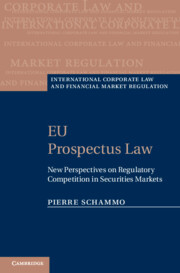Book contents
- Frontmatter
- Contents
- Preface and acknowledgements
- List of abbreviations
- Table of cases
- Table of legislation
- Introduction
- PART I Prospectus disclosure in a wider institutional context
- PART II Prospectus disclosure regulation
- 2 Introduction
- 3 (Maximum) harmonisation
- 4 Equivalence-based regulation
- PART III Prospectus disclosure enforcement
- PART IV Prospectus disclosure and regulatory competition
- PART V Conclusions and suggestions for the future
- Select bibliography
- Index
4 - Equivalence-based regulation
from PART II - Prospectus disclosure regulation
Published online by Cambridge University Press: 01 June 2011
- Frontmatter
- Contents
- Preface and acknowledgements
- List of abbreviations
- Table of cases
- Table of legislation
- Introduction
- PART I Prospectus disclosure in a wider institutional context
- PART II Prospectus disclosure regulation
- 2 Introduction
- 3 (Maximum) harmonisation
- 4 Equivalence-based regulation
- PART III Prospectus disclosure enforcement
- PART IV Prospectus disclosure and regulatory competition
- PART V Conclusions and suggestions for the future
- Select bibliography
- Index
Summary
Introduction
One of the distinctive features of the Prospectus Directive (‘PD’) is that its provisions apply to companies incorporated in a Member State (‘EU issuers’) and outside the EU (‘third country issuers’) that wish to raise capital in the EU by making a public offer or seeking admission of securities to trading on a regulated market in a Member State. Where applicable, the PD provides for a prospectus to be prepared, approved and published according to its provisions and its implementing legislation (the ‘Prospectus Regulation’ or ‘PR’). Recall that the latter lays down the ‘maximum harmonisation’ disclosure requirements that apply to EU issuers and, generally, third country issuers. But there is a special set of arrangements for third country issuers. First, when preparing financial information, third country issuers may be able to rely on third country accounting standards that are deemed to be equivalent to the relevant European standards. In other cases, they may not have to comply with the common EU disclosure items at all. They may instead be allowed to rely on third country prospectus documentation for a public offer or an admission to trading on a regulated market in the EU (a ‘third country prospectus’ as opposed to an ‘EU prospectus’ when prepared in accordance with EU disclosure standards), provided that the third country requirements are, inter alia, considered to be equivalent to European requirements.
- Type
- Chapter
- Information
- EU Prospectus LawNew Perspectives on Regulatory Competition in Securities Markets, pp. 142 - 190Publisher: Cambridge University PressPrint publication year: 2011

